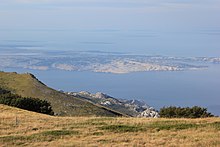Slana concentration camp

The concentration camp Slana ( Serbo-Croatian Koncentracioni Logor Slana , Концентрациони логор Слана), named after the bay Slana on the Adriatic island of Pag , near the eponymous town of Pag , during was World War II, a concentration and extermination camps in the former Independent State of Croatia (NDH), a vassal state of the fascist Axis powers .
It was in operation from July to August 1941 and was one of the most notorious camps in what was then occupied south-eastern Europe . The prisoners were mainly Serbs , Jews and Roma , but there were also Croatians who were critical of the regime . With the Metajna concentration camp , it was one of the island's two concentration camps.
history
On June 25, 1941, on the instructions of Mijo Babić , the representative of Department III of the Ustaša Control Service (UNS), which was responsible for the establishment, control and organization of the concentration camps in the NDH state, the island's first concentration and extermination camp Pag, more precisely in the Slana Bay , built a camp for men. The first prisoners came from Gospić . There it came to ill-treatment , torture and killings . The victims were often brutally murdered and then thrown into pits, ravines , dug mass graves or into the Adriatic Sea . The death toll, especially Serbs and Jews, is estimated at several thousand. The camp was closed after the island was handed over to Italian forces at the end of August 1941 . Most of the survivors were transported to the Jasenovac concentration camp via the Jastrebarsko concentration camp . The Slana concentration camp was next to the Metajna concentration camp the second camp on the Adriatic island of Pag, in which systematic murder was carried out.
Commemoration
A memorial service in honor of the victims was not made possible for the first time until 1990. The second took place in 2009 in the presence of the then Croatian President Stjepan Mesić . The then President of Serbia Boris Tadić was present at the 2011 commemoration . A memorial plaque in honor of the victims was only erected decades later, on September 17, 1975, but was destroyed in 1991 by nationalist Croats. A replica of the original monument was inaugurated on June 26, 2010, but was destroyed within just two days. On June 29, 2013, a new memorial plaque was placed on the initiative of the Serbian National Council (SNV) and the Jewish community of Croatia as well as the local anti-fascist movement and the Jadovno 1941 association , but on the night of July 19, 2013 the memorial plaque of unknowns became a total destroyed third time. To this day, nothing on Pag reminds of the crimes committed in the summer of 1941.
Individual evidence
- ↑ a b c d e f g h i j k l Wolfgang Benz , Barbara Distel (ed.): The place of terror . History of the National Socialist Concentration Camps. Volume 9: Labor education camps, ghettos, youth protection camps, police detention camps, special camps, gypsy camps, forced labor camps. CH Beck, Munich 2009, ISBN 978-3-406-57238-8 , p. 326.
- ↑ Hans-Christian Petersen, Samuel Salzborn (ed.): Antisemitism in Eastern Europe: History and Present in Comparison. Lang , Frankfurt 2010, ISBN 978-3-631-59828-3 , p. 70.
- ^ Till Bastian : Sinti and Roma in the Third Reich: History of a persecution. Verlag CH Beck, Munich 2001, ISBN 3-406-47551-5 , p. 72.
- ↑ a b c d e f RTS : Уништена спомен-плоча жртвама усташа - memorial plaque destroyed in honor of the Ustaša victims Added on October 26, 2013.